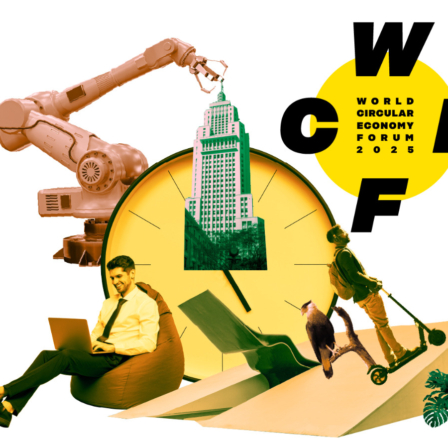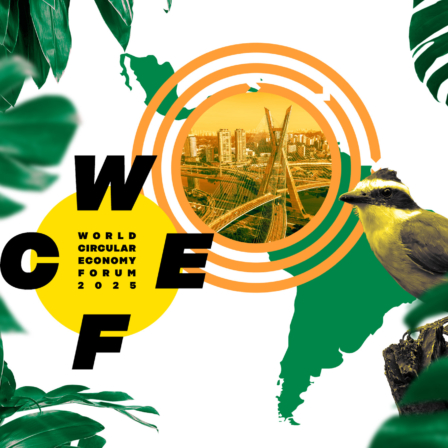The circular and climate communities brought together
In mid-April 2021 I had the pleasure to be the co-host of another World Circular Economy Forum event, this time focusing especially on the potential of circularity in tackling climate change. I found it especially remarkable how the WCEF+Climate event brought together – maybe for the first time – the circular and climate communities. Almost every single speaker underlined how a circular economy is not only a crucial part in achieving our climate goals but an opportunity for increased well–being across societies.
We know that the path to a circular economy will not be the same everywhere and its concept differs among societies leaning heavily on primary production compared to service-based societies. Therefore, the opportunities it offers are different, such as increasing working environments in the informal market, building economic growth based on services and producer ownership models and addressing the alarming fact that man-made mass has exceeded living biomass.
Circular economy is smart
Our current linear economic system has turned out to be problematic in numerous ways and it requires profound reshaping. It has brought us to the situation where, to be blunt, we can say that the current economic system is bad for the climate, biodiversity and society and it’s also bad for the economy itself.
We know we have to tackle climate change, improve biodiversity and reduce the overconsumption of natural resources. Like Executive Director of UNEP Inger Andersen said at WCEF+Climate: “We must make peace with nature”. To truly address the multiple and complex challenges, the tools we use must make economic sense to ensure they don’t compromise social well-being. The value of a circular economy lies in its potential to support a future within the planetary boundaries without compromising economic growth.
Regulations and trade policies in scaling up the transition
Regarding the circular transition, I want to underline the importance of policies and regulations. Market regulations and trade policies can create a favourable environment for the circular economy. In today’s global economy it is obligatory for us to look at trade if we wish to scale up circularity. Circular trade policies facilitate the adoption of circular solutions. In addition to looking at the trade of products and materials, we should focus on services which are important in keeping materials in use. Decision-makers play an important role in this by laying grounds for circular businesses to succeed over linear business models.
While trade policies can embed circularity across global value chains, public procurement is an example of an efficient tool to push for circular solutions on a national level. Through public procurement, the public sector has power to direct the use of funds from linear based products to circular products and services, for example by setting clear minimum criteria on the materials used, the life cycles of procured products and by using products-as-a-service over purchases. This has a clear impact – in Finland alone, public procurement was estimated to have a value of 35 billion euros and cover almost 20% of GDP in 2016.
The future is built together
Platforms for collaboration such as the World Circular Economy Forum (WCEF), the Global Alliance for a Circular Economy and Resource Efficiency (GACERE) and the Platform for Accelerating a Circular Economy (PACE) are crucial. As working together is in the DNA of Sitra and is the backbone of the WCEF, I am glad to be able to contribute on these crucial topics also as a member of the PACE board. The Action Agendas PACE recently published provide an in-depth viewpoint of the actions needed to speed up the transition to a circular economy in key sectors. Our work at Sitra manages to cover a few of these calls to action, but the crucial point is that we all must do our part to achieve this transition.
The WCEF is a platform for stakeholders to communicate the priorities and actions across the whole circular community. I also see it as a way to bring parties together and to build on each other’s work. With excitement I am turning my eyes to a new continent for the WCEF2021 and inviting all to take part in the annual event on 13-15 September 2021, hosted by the Government of Canada and Sitra.
Sitra’s vision and way forward
In the light of the future endeavours, I want to bring up Sitra’s new strategy, published in December 2020, which will guide our work through the coming years. Our goal is to ensure that economic growth improves biodiversity and is in balance with the environment. We will focus on three interlinked themes: sustainability solutions, a fair data economy, and democracy and inclusivity. These themes are closely connected: the urgency to live within our planetary boundaries and the ongoing digital transition will shape our future in unexpected ways.
The circular economy is part of the glue that binds together the need to tackle climate change, the loss of biodiversity and the overconsumption of natural resources with an inclusive democracy, economic growth and increasing social well-being. Data and digital solutions are crucial in ensuring that economic development is in line with the planetary boundaries.
Leaning on our strategy and the valuable work our partners are doing, we aim to remain in the frontline of change and invite everyone to join us.

















Recommended
Have some more.